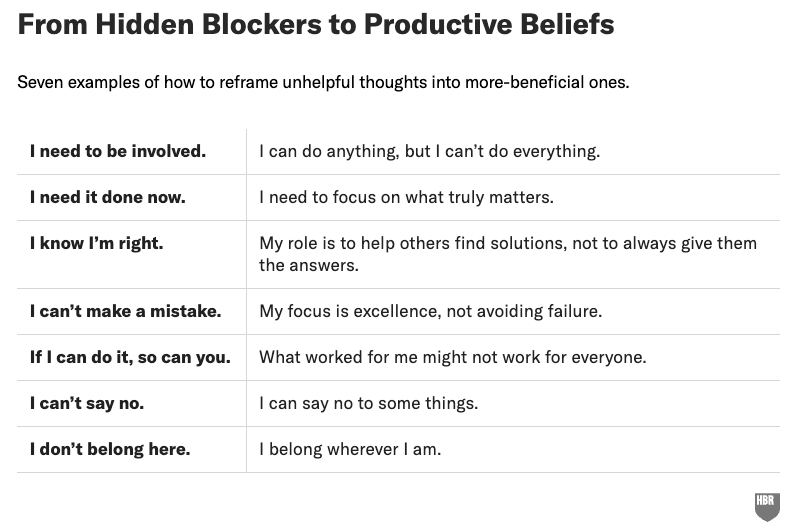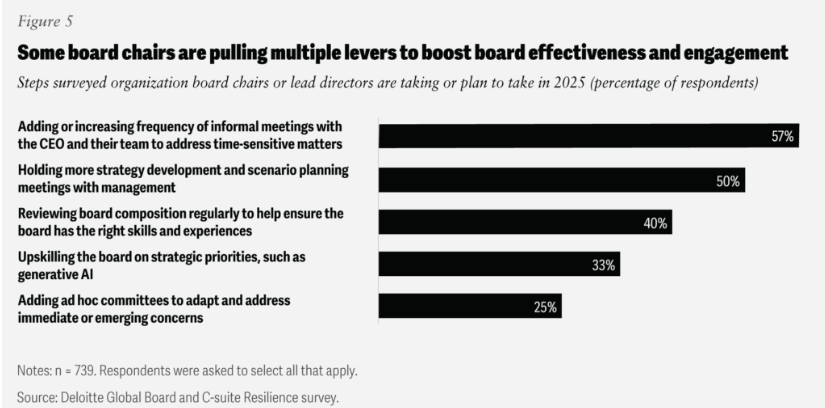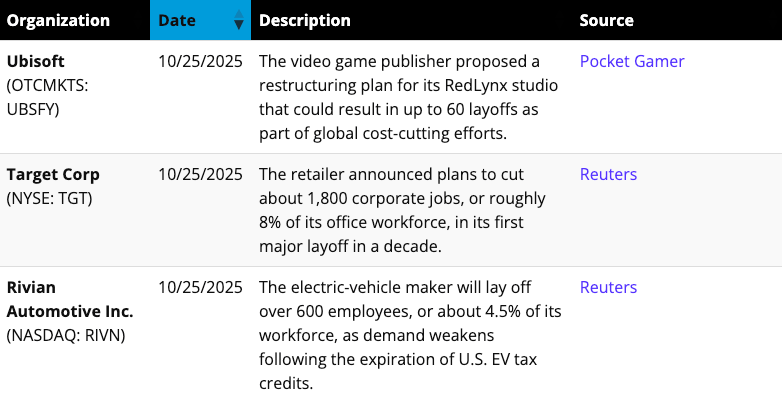- Talent Edge Weekly
- Posts
- Talent Edge Weekly - Issue #320
Talent Edge Weekly - Issue #320
Limiting beliefs that hold leaders back, barriers to internal mobility, determining whether a newly vacant role needs to be backfilled, scenario planning, and the return on investment of AI in the workplace.
Welcome to this week’s issue of Talent Edge Weekly!
A shout-out to Bridget Penney, Chief People Officer at Applied Systems, for referring new subscribers to Talent Edge Weekly. Thank you, Bridget, for your support of this newsletter!
PRESENTED BY The i4cp Next Practices Now Conference
How do you build a future-ready organization?
i4cp's Next Practices Now Conference (March 30 – April 2, in-person or virtual) is your opportunity to stay ahead of industry trends and explore what makes future-ready organizations thrive.
Unlike most conferences, i4cp’s event:
Has no vendors. Only HR practitioners are allowed
Connects you with 500+ HR execs and decision makers
Focuses on strategic issues, from AI to culture
Offers a CHRO-led agenda, with leaders from John Deere, Zillow, DICK’S, Accenture & more
Sign up by Dec. 12 to save $300, and use the code TALENTWEEKLY to save another $300—for a limited time.
THIS WEEK'S CONTENT
Below are links and descriptions of the topics covered in this issue. If you're interested in my deep dive, you can read the full newsletter.
The Hidden Beliefs that Hold Leaders Back | Harvard Business Review | Explores seven hidden beliefs that can quietly hinder leadership effectiveness and offers a three-step framework to help leaders overcome them.
Barriers to Internal Mobility and Potential Policies to Reevaluate | Brian Heger | My one-pager highlights nine barriers to internal mobility; I expand on one to help organizations strengthen their internal talent movement strategies.
Does That Newly Vacant Role Really Need to Be Backfilled? Breaking the Cycle of Overhiring | Brian Heger | My cheat sheet with 8 questions to help hiring managers determine if a vacant role truly needs to be backfilled.
How Board and C-Suite Collaboration Can Build Organizational Resilience | Harvard Law School Forum on Corporate Governance | Covers how Boards are prioritizing various activities, including scenario planning. I reshare my one-pager on connecting workforce planning and scenario planning.
AI Implementation Strategies: 4 Insights from MIT Sloan Management Review | MIT Sloan Management Review | Summarizes insights from four articles showing how organizations are moving beyond AI experimentation to measurable business impact.
Also, check out my job cuts tracker & Chief HR Officer move of the week.
Let’s dive in! ⬇️
THIS WEEK'S EDGE

LEADERSHIP EFFECTIVENESS
Explores seven hidden beliefs that can quietly hinder leadership effectiveness and offers a three-step framework to help leaders overcome them.
It’s not uncommon for leaders to hold internal beliefs that quietly hinder their effectiveness. This new article highlights seven of these limiting beliefs that often go unnoticed: 1) I need to be involved (a tendency to micromanage and control every detail), 2) I need it done now (a sense of false urgency that leads to rushed work and burnout), 3) I know I’m right (an overreliance on one’s own ideas that stifles collaboration), 4) I can’t make a mistake (a fear of failure that drives perfectionism and indecision), 5) If I can do it, so can you (unrealistic expectations that limit others’ growth), 6) I can’t say no (difficulty setting boundaries, resulting in overcommitment), and 7) I don’t belong here (feelings of self-doubt or impostor syndrome). To begin moving past them, the article outlines a three-step approach that includes identifying the limiting belief and reframing it into a more constructive mindset reinforced by action. For instance, turning “I can’t make a mistake” into “my focus is excellence, not avoiding failure.” While overcoming these beliefs is not easy, starting by identifying them is an important first step. Two questions I like to ask others for my own development: What is one specific behavior you feel gets in the way of my full potential as a leader? What is one suggestion you have for overcoming this barrier? If you are a leader or manager, consider asking these questions in your next team meeting. And if you are a team member, it could be an opportunity to share this feedback proactively during your next 1:1. The answers can lead to meaningful breakthroughs in leadership effectiveness and team performance.

INTERNAL MOBILITY
My one-pager highlights nine barriers to internal mobility; I expand on one to help organizations strengthen their internal talent movement strategies.
Many organizations continue to adopt more flexible work models, including tactics to better deploy internal talent (current employees) to work opportunities where and when they’re needed. These opportunities range from short-term assignments and projects to new roles. As I noted in my book chapter, Enabling Strategic Workforce Planning Through Skills, Artificial Intelligence, and Internal Talent Marketplaces, published in Strategic Workforce Planning: Best Practices and Emerging Directions (The Society for Industrial and Organizational Psychology Professional Practice Series, March 29, 2024), activating internal talent movement requires intentional consideration of several factors. While technology is a significant enabler of internal mobility (IM), it is not sufficient on its own. Stated differently, even the best technology will fall short when non-technical factors are not intentionally addressed. Therefore, internal mobility strategies must ensure these factors are carefully evaluated and planned for to realize the full benefits that IM technology can provide. To help think through these aspects, my cheat sheet brings together nine barriers to internal mobility and expands on one of them (mobility policies that might hinder internal movement). You can use this cheat sheet to spark discussions that help you think through the different elements involved in using internal talent movement as a key lever for driving business performance.

TALENT ACQUISITION
My cheat sheet with 8 questions to help hiring managers determine if a vacant role truly needs to be backfilled.
Over the past few years, I’ve tracked thousands of layoff announcements through my layoff tracker on brianheger.com. A consistent theme has emerged: many organizations cite overhiring as the reason for workforce reductions. Overhiring often occurs when companies rapidly scale to meet short-term demand or pursue aggressive growth targets, only to realize later that staffing exceeds sustainable needs. This leads to costly cycles of hiring, layoffs, and rehiring. While better workforce planning can reduce this risk, an equally important—and often overlooked—practice is questioning whether roles truly need to be backfilled when they become vacant. Too often, the process looks like this: 1) a position becomes vacant either through an internal job move or a resignation; 2) the job is posted because it’s assumed it needs to be backfilled, and 3) recruiting teams start sourcing. However, a newly vacated role presents an opportunity to reassess the work—what’s essential, what can evolve, and what may no longer be needed. Talent acquisition teams and HR business partners can have strategic discussions that help hiring managers evaluate decisions with questions like: “Has the business context changed since we initially staffed this role?”, “Would technology (AI or process redesign) change how this work is done?”, and “How likely is this role to remain critical two years from now?” Replacing reflexive hiring with strategic reviews can help organizations break the cycle of overhiring and optimize resources. To support these conversations, I’ve developed this one-page cheat sheet with eight sample questions to guide rehiring decisions.

SCENARIO PLANNING
Covers how Boards are prioritizing various activities, including scenario planning. I reshare my one-pager on connecting workforce planning and scenario planning.
This new article—based on a Deloitte Global Boardroom survey of 739 board and executive leaders—highlights how leaders are increasing their focus on scenario planning to navigate ongoing uncertainty. Nearly three-quarters of respondents report that their organizations are spending more time exploring “what-if” futures to act faster when conditions change. As Robert Herz, Independent Director at Morgan Stanley and Workiva, noted, effective scenario planning helps organizations “prepare a playbook if particular scenarios were to materialize.” Roy Dunbar, who serves on several boards, including McKesson and Duke Energy, added that the best scenario-planning discussions should yield “real clarity on threats, opportunities, and where growth will come from.” While nearly 73% of survey respondents said they’ve increased their time spent on scenario planning, only 26% have significantly increased it—indicating that many organizations still underinvest in this practice. As I’ve mentioned in several posts, one way HR practitioners can enhance scenario readiness is through strategic workforce planning (SWP). SWP helps leaders anticipate how roles, skills, and workforce needs might adjust under different business conditions. To support these discussions, I’m resharing my one-page cheat sheet to help teams gain directional insights on how workforce and talent needs might shift under different business scenarios their organizations may face.

AI AND RETURN ON INVESTMENT
Summarizes insights from four articles showing how organizations are moving beyond AI experimentation to measurable business impact.
This short-form MIT Sloan Management Review piece summarizes insights from four of its recent articles on how organizations are maximizing AI’s business impact, with links to each full article. Anchored in the premise that “when implementing artificial intelligence, enterprise leaders must consider where AI will create value, not just where it will be useful,” it highlights how leading firms are moving from experimentation to measurable outcomes. One example is Michelin Group—a French multinational manufacturing company—that determines which AI projects advance beyond the proof-of-concept stage through a disciplined, value-driven approach. Each proposed use case is first evaluated for potential ROI, scalability, and business relevance. Only those that show clear performance impact—such as cost reduction, productivity gains, or sustainability benefits—move to deployment. Michelin’s AI Center of Excellence then conducts post-deployment reviews to confirm realized value and ensure alignment with its ethical AI principles. Michelin has scaled more than 200 AI use cases in predictive maintenance, quality inspection, and inventory management, generating over €50 million in annual ROI and 40% yearly growth in AI-enabled value creation.
MOST POPULAR FROM LAST WEEK
PERFORMANCE MANAGEMENT
My cheat sheet with questions to help managers prepare for performance calibration discussions and drive more objective, consistent evaluations.
With 67 days left in 2025 to influence performance and outcomes, many organizations are also preparing for—or already conducting—performance calibration discussions. These are sessions where managers come together to ensure greater consistency and objectivity in performance evaluations. They aim to promote fairness by addressing discrepancies between “tough graders,” who hold employees to exceptionally high standards, and “easy graders,” who offer overly generous evaluations. To help managers prepare, I’ve created a one-pager featuring 10 sample questions. Reflecting on questions like these can help managers approach evaluations more thoughtfully and objectively. Employees can also use them to reflect on their performance and contributions.
JOB CUTS AND LAYOFF TRACKER
Check out my tracker of announcements from a segment of organizations that have conducted job cuts and layoffs since the start of 2023.
A few job cuts announced this past week:
Charter Communications (NASDAQ: CHTR). The telecom operator is reportingly cutting ~1,200 corporate and back-office jobs, or just over 1% of its workforce, to streamline operations amid its pending $34.5 billion merger with Cox.
Molson Coors Beverage Co (NYSE: TAP). The brewer announced it will cut about 400 salaried jobs, or roughly 9% of its workforce across the Americas, by year-end as part of a restructuring to streamline operations and reinvest in growth areas.
Target Corp (NYSE: TGT). The retailer announced plans to cut about 1,800 corporate jobs, or roughly 8% of its office workforce, in its first major layoff in a decade.
CHIEF HR OFFICER MOVE OF THE WEEK
This past week, 9 new CHRO announcements were posted on CHROs on the Go, my subscription platform tracking movement in and out of the CHRO role.
This week’s CHRO move of the week is:
J.Crew Group (NEW YORK, NEW YORK)—a widely recognized and celebrated portfolio of American lifestyle brands, J.Crew and Madewell—announced that Gena Smith is joining the company as Chief Human Resources Officer. She is based in New York and will report to Libby Wadle, Chief Executive Officer of J.Crew Group. Gena joins J.Crew from LVMH North America, where she served as Chief Human Resources Officer for almost the last four years of her 14-year tenure with the organization
‘Read Online’ if email cuts off ✂️
👉️ To join a monthly or yearly subscription, click here.
CHROs on the Go has over 4,500 archived announcements in its online platform, with new announcements added daily!
If you are already a subscriber to CHROs on the Go, log in here.
FROM ME ON LINKEDIN
Catch up on what you may have missed from me on LinkedIn:
THE BEST OF SEPTEMBER 2025
Did you miss the “Best of September ” issue of Talent Edge Weekly? If so, check out issue #316, which includes the most popular resources from the month.
Thank you to SuccessionHR, who sponsored the Best of September.
Want to get your brand, product, or service in front of our active 55,000+ Talent Edge Weekly subscribers? Learn how to become a potential sponsor.
Talent Edge Weekly is written by Brian Heger, a human resources practitioner. You can connect with Brian on LinkedIn and brianheger.com
🗣️ WANT MORE?
Are you an internal HR practitioner?
👉️ Apply for my private, paid community, Talent Edge Circle
Are you a provider of HR-related services?
👉️ Become a sponsor of Talent Edge Weekly
Want to know who’s moving in and out of the CHRO role?
👉️ Join my CHROS on the Go subscription












